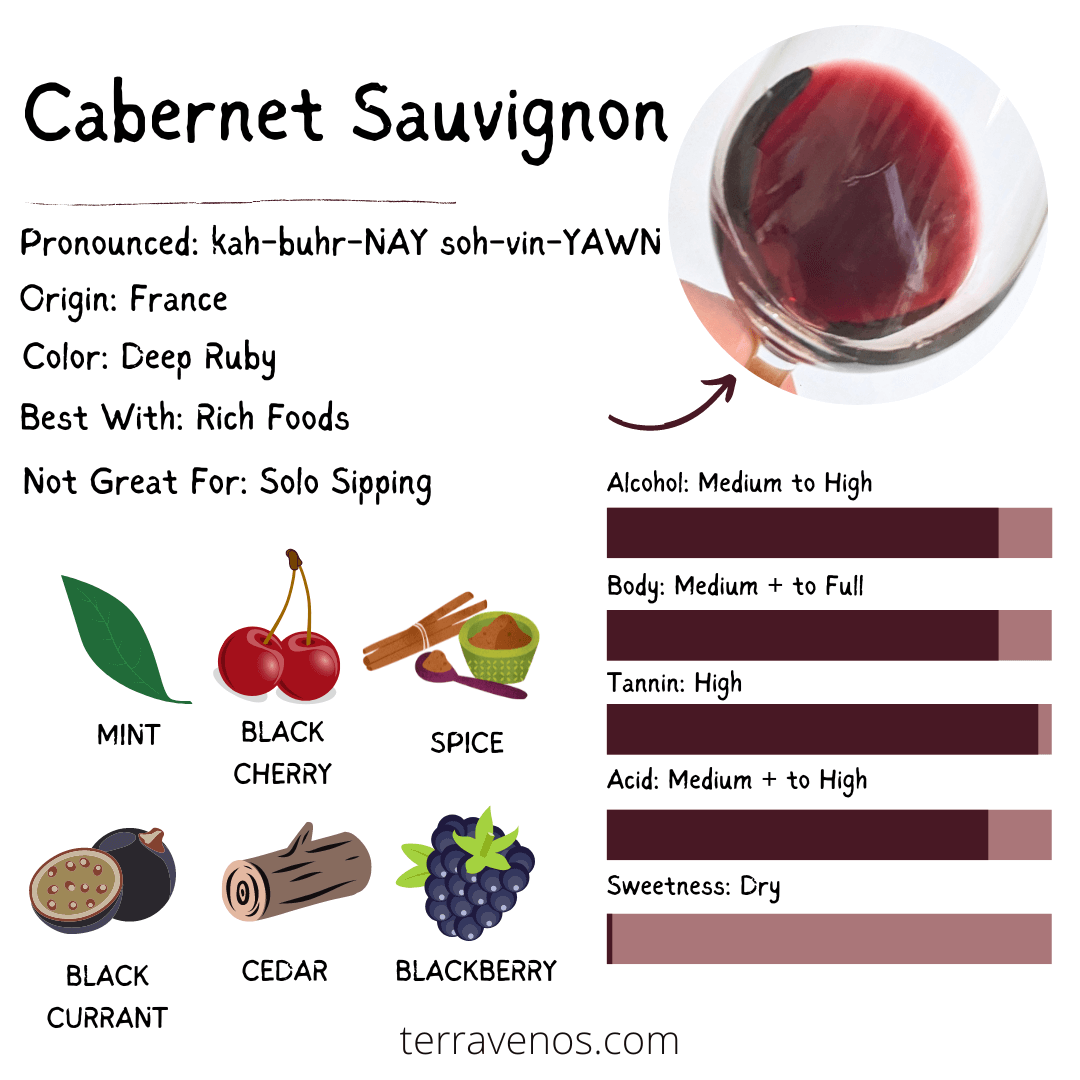
Pronunciation: kah-buhr-NAY soh-vin-YAWN
Cabernet Sauvignon, a red wine varietal, is renowned worldwide for its exceptional qualities. Originally from Bordeaux, France, today Cabernet Sauvignon is found around the world with its full-body and black fruit flavors.
- What Kind of Wine Is Cabernet Sauvignon?
- Where Does Cabernet Sauvignon Wine Come From?
- What Does Cabernet Sauvignon Smell Like?
- What Does Cabernet Sauvignon Taste Like?
- How to Serve Cabernet Sauvignon Wine
- Cabernet Sauvignon Food Pairing Suggestions
- Cabernet Sauvignon vs. Other Varietals
- Sustainable Practices in Cabernet Sauvignon Vineyards
- Notable Cabernet Sauvignon Producers and Bottles to Try
- Emerging Trends and Innovations
- Final Thoughts – Cabernet Sauvignon as a Must-Try Red Wine Varietal
What Kind of Wine Is Cabernet Sauvignon?

Cabernet Sauvignon is a medium to full-bodied red wine with moderate acidity, pronounced tannins, and a moderate alcohol content. Its style typically falls between that of Merlot and Cabernet Franc, offering a unique and distinct character.
Where Does Cabernet Sauvignon Wine Come From?
Cabernet Sauvignon, a grape variety originating from the Bordeaux region of France, has spread its influence across the globe. Bordeaux, particularly the Left Bank, holds a special place for Cabernet Sauvignon, where it contributes to some of the world’s most renowned wines. Additionally, Cabernet Sauvignon has found success in various other wine regions around the world.
Cabernet Sauvignon in Bordeaux
In Bordeaux, Cabernet Sauvignon is one of the five primary grape varieties used in winemaking, alongside Cabernet Franc, Merlot, Malbec, and Petit Verdot. The Left Bank of Bordeaux, home to prestigious châteaux like Lafite Rothschild and Margaux, showcases the exceptional use of Cabernet Sauvignon in crafting complex and age-worthy wines.
Explore the map above to see where Cabernet Sauvignon grows in Bordeaux. Look to the North of the city of Bordeaux.
Helpful Tip: Head over to this post that goes into what makes a wine a Bordeaux.
Cabernet Sauvignon in Other Wine Regions
Beyond Bordeaux, Cabernet Sauvignon has thrived in numerous wine regions across the globe.
Napa Valley, renowned for its Cabernet Sauvignon production, consistently produces exceptional wines that highlight the grape’s rich and powerful character.
Other regions, such as Chile, Argentina, Australia, South Africa, Italy, and Washington State, have also embraced Cabernet Sauvignon and achieved remarkable success with its cultivation and winemaking.
What Does Cabernet Sauvignon Smell Like?
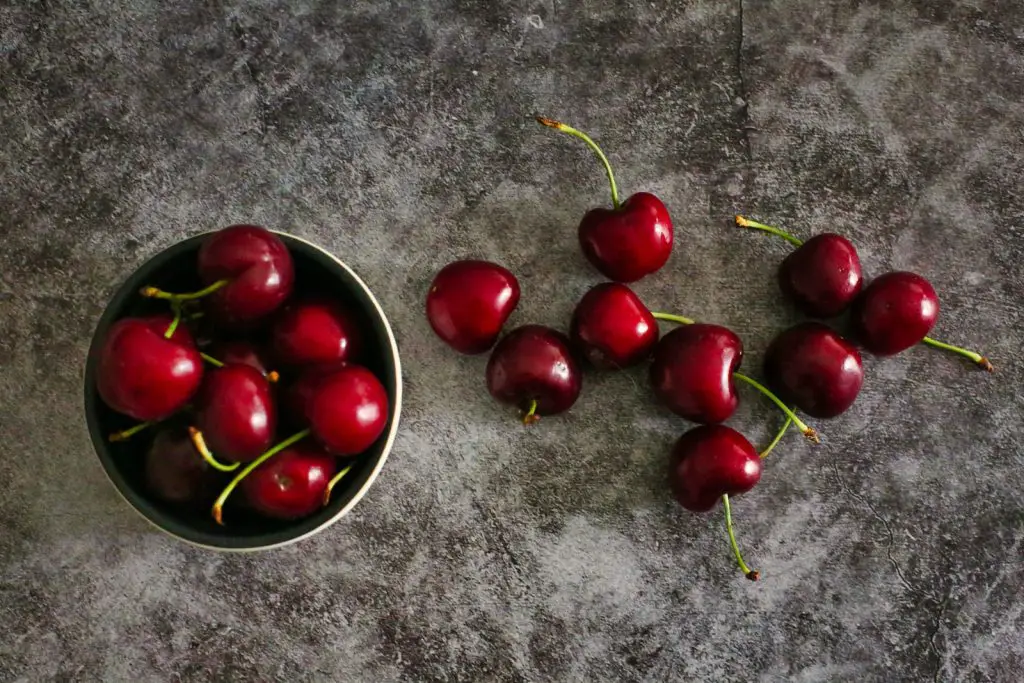
Cabernet Sauvignon exhibits a distinctive aroma profile that includes dark fruits such as blackcurrant (a.k.a. cassis), blackberry, and black cherry. It often presents secondary aromas of cedar, tobacco, and subtle hints of vanilla imparted by oak aging. The complex aromatic layers of Cabernet Sauvignon is one of the main reasons it’s such a popular wine.
What Does Cabernet Sauvignon Taste Like?
Cabernet Sauvignon offers a wide range of flavors that evolve depending on the region and winemaking style. Common taste descriptors include blackcurrant, blackberry, plum, and black cherry. The wine’s structure is characterized by firm tannins and a balanced acidity that provides a robust foundation. With aging, Cabernet Sauvignon develops additional complexities, offering nuances of spice, leather, and earthy notes.
How to Serve Cabernet Sauvignon Wine
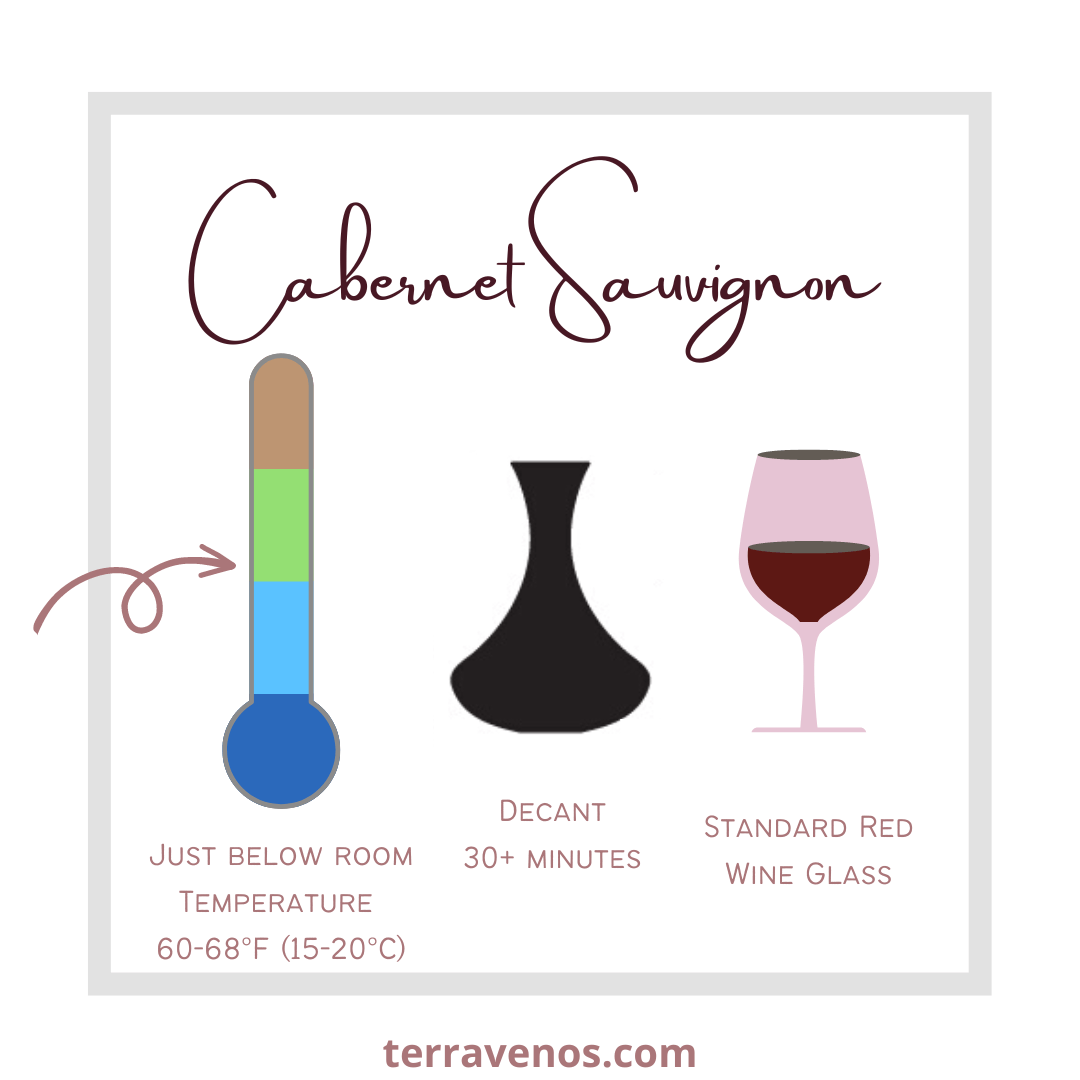
Temperature
Serve Cabernet Sauvignon at a temperature slightly below room temperature, typically around 60-68°F (15-20°C). This temperature range allows the wine’s aromas to fully express themselves while ensuring that the alcohol does not overpower the sensory experience.
Glassware
Select a standard red wine glass with a broad bowl and a slightly tapered rim. This shape encourages proper aeration and directs the wine’s aromas toward the nose, enhancing the overall tasting experience.
Decanting
For young and tannic Cabernet Sauvignon wines, decanting is recommended to allow the flavors and aromas to open up. Decanting time can vary but typically ranges from 30 minutes to a couple of hours, depending on the wine’s age and structure. However, mature and delicate Cabernet Sauvignon wines may require less or no decanting to preserve their nuances.
Helpful Wine Drinking Tip: If you purchased an inexpensive, everyday bottle of Cabernet Sauvignon, it probably needs very little decanting. Pour yourself a glass and give it a good swirl. If it seems aromatic, then it’s good to go. If it seems a little closed, give it another 5 minutes and another strong swirl.
Aging Potential
Cabernet Sauvignon is renowned for its aging potential. With proper cellaring conditions, high-quality Cabernet Sauvignon wines can develop beautifully over many years. While some lighter styles may be enjoyed within 3-5 years, full-bodied and structured Cabernet Sauvignon wines can age gracefully for a decade or more, allowing their flavors to evolve and mature.
Here’s a very quick and dirty guide to aging Cabernet Sauvignon:
- Inexpensive Cabernet Sauvignon: Don’t age, drink.
- Mid-priced, lighter styles of Cabernet Sauvignon: 3-5 years.
- Full-bodied, high-tannin, high-acid Cabernet Sauvignon: 10+ years.
Helpful Tip: Alcohol, acid, and tannin all help protect wines while aging. If your Cabernet Sauvignon has high levels of all 3 of these structural components, then it’s a good candidate for aging.
Cabernet Sauvignon Food Pairing Suggestions
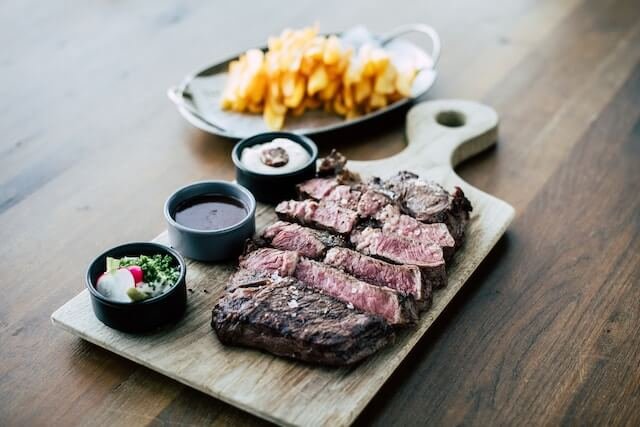
Cabernet Sauvignon’s bold character and complex flavors make it a versatile companion for various culinary delights. Its robust tannins and acidity harmonize with rich, flavorful dishes, offering a delightful sensory experience.
Consider these food pairing suggestions for Cabernet Sauvignon:
- Grilled or Roasted Meats: grilled steaks, lamb chops, or roasted beef tenderloin
- Aged Cheeses: Cheddar, Gouda, or Parmigiano-Reggiano
- Grilled Portobello Mushrooms with Balsamic Reduction (vegan Cab pairing option)
- Discover: Cabernet Sauvignon Cheese Pairing Guide
Helpful Tip: Cabernet Sauvignon’s high tannins need rich, fatty foods to help balance them out. Head over to this post to discover more about the basics of food and wine pairing.
Cabernet Sauvignon vs. Other Varietals
| Characteristics | Cabernet Sauvignon | Cabernet Franc | Merlot |
|---|---|---|---|
| Overall Profile | Full-bodied, structured, and bold | Medium-bodied, aromatic, and elegant | Medium-bodied, smooth, and approachable |
| Aroma | Blackcurrant, blackberry, mint, cedar | Raspberry, red currant, bell pepper, violet | Plum, cherry, mocha, tobacco |
| Flavor Profile | Dark fruits, cassis, black cherry, tobacco | Red fruits, cherry, herbal notes, earthiness | Red and black fruits, chocolate, coffee |
| Tannins | High tannins, firm and grippy | Moderate tannins, smooth texture | Soft tannins, velvety texture |
| Acidity | Moderate to high | Moderate to high | Moderate to high |
| Oak Influence | Often oaked, with flavors of cedar, vanilla, and spice | Light oak influence, herbaceous notes | Moderate oak influence, hints of vanilla |
| Aging Potential | Excellent aging potential, can develop complexity over time | Moderate aging potential, best enjoyed within 5-7 years | Moderate aging potential, best enjoyed within 3-5 years |
| Food Pairing | Grilled red meats, hearty stews, aged cheeses | Roast poultry, grilled vegetables, charcuterie | Roasted lamb, pasta dishes, mushroom-based dishes |
| Regional Focus | Bordeaux (France), Napa Valley (California, USA) | Loire Valley (France), Tuscany (Italy) | Bordeaux (France), Tuscany (Italy), California (USA) |
While Cabernet Sauvignon shares some similarities with its relative, Cabernet Franc, it has its own unique qualities. Cabernet Sauvignon is known for its fuller body, bolder tannins, and more pronounced black fruit flavors.
Compared to Merlot and other red varietals, Cabernet Sauvignon exhibits greater intensity, depth, and aging potential, making it a standout for wine lovers looking for wines that they can cellar and age.
Discover More:
Cabernet Sauvignon vs Cabernet Franc
Cabernet Sauvignon vs Merlot
Cabernet Sauvignon vs Malbec
Cabernet Sauvignon vs Chardonnay
Cabernet Sauvignon or Pinot Noir?
Sangiovese vs Cabernet Sauvignon
Sustainable Practices in Cabernet Sauvignon Vineyards
Today, sustainability plays a crucial role in viticulture and winemaking practices. One of the biggest challenges facing Cabernet Sauvignon vineyards is warming temperatures.
Increased temperatures in the vineyard can lead to unbalanced wines, which unfortunately affects some of the most famous vineyard sites in the world.
Today, growers are experimenting with adapting pruning techniques as well as changing the types of grapes that they grow to accommodate warming temperatures.
Notable Cabernet Sauvignon Producers and Bottles to Try
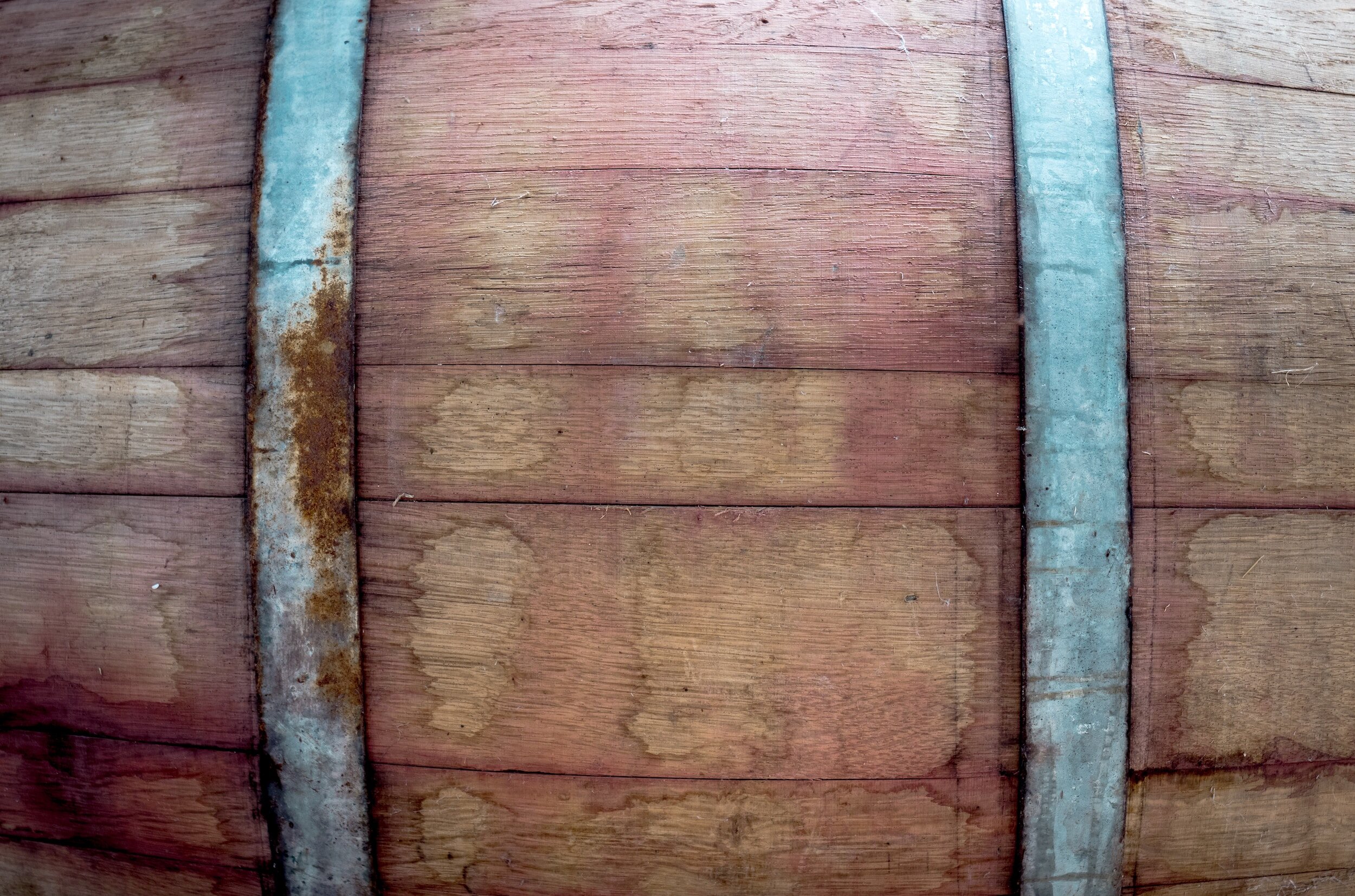
When exploring Cabernet Sauvignon, you’ll find quality wines made from producers around the world. Some are uber-famous and make cult wines.
Here are a few notable wineries crafting cult Cabernet wines:
- Château Latour (Pauillac, Bordeaux, France)
- Ridge Vineyards (Santa Cruz Mountains, California, USA)
- Catena Zapata (Mendoza, Argentina)
- Penfolds (South Australia)
- Screaming Eagle Winery (Napa Valley, California, USA)
These wineries showcase the diversity and excellence that can be achieved with Cabernet Sauvignon, and they’re certainly some of the most renowned producers, but you’ll find quality, affordable Cabernet Sauvignon wherever you buy your wines.
Check out this fantastic overview video of Catena Zapata:

Emerging Trends and Innovations
The world of wine continually evolves, and Cabernet Sauvignon remains at the forefront of innovation. Winemakers constantly explore new techniques and styles, pushing the boundaries of tradition. From experimental aging methods to novel vineyard practices, these innovations contribute to the ever-evolving landscape of Cabernet Sauvignon, introducing exciting new dimensions to its already captivating character.
Final Thoughts – Cabernet Sauvignon as a Must-Try Red Wine Varietal
With its bold flavors, impressive structure, and remarkable aging potential, Cabernet Sauvignon deserves a place in your wine glass. Its ability to convey the essence of the terroir, coupled with its genuine ability to pair with hearty foods makes it an excellent wine.
Three key takeaways to remember:
1. Distinctive Flavor Profile: Cabernet Sauvignon delights with flavors of blackcurrant, blackberry, and plum, accompanied by hints of cedar and tobacco.
2. Versatility in Food Pairing: Pair Cabernet Sauvignon with grilled or roasted meats, aged cheeses, and grilled mushrooms. Think rich and savory.
3. Aging Potential: Thanks to those high tannins and full-body, Cabernet Sauvignon can age gracefully over time.
Thirsty for More?
For a deeper exploration of the unique characteristics of Cabernet Sauvignon and a comparison to Pinot Noir, delve into this in-depth post.
If you enjoy bold red wines, here are a few more strong red wine recommendations to expand your palate.
Planning a red wine tasting? Check out this list of cold appetizers that perfectly complement a variety of red wines.



